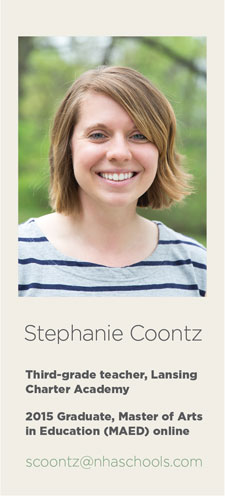 A teacher’s take on the online master’s degree
A teacher’s take on the online master’s degree
As an elementary teacher, I’ve always loved the excitement of going back to school. Call me crazy, but I find a small thrill in seeing the displays of discount school supplies and fall clothing back in stores. Beginning my master’s degree program, however, was a different back-to-school experience. There was no need to buy carts of pencils and folders printed with colorful designs. Instead of greeting my friends with smiles and conversations about summer vacation on the first day of school, I simply needed to turn on my computer. From start to finish, my program for the College of Education took place online, and while this was a new experience for me, it was one I quickly came to appreciate. I spent my days teaching my third-grade students and then came home to study and complete coursework. While I sometimes missed the face-to-face interaction that models a traditional classroom setting, I found the online format aligned well with my schedule, making it possible for me to work and be in school at the same time.
A new kind of classroom
In other ways too, the Master of Arts in Education (MAED) program differed from my previous classroom experiences. School had always been the necessary step in working toward something, whether it was a higher level of education or a career, but I found myself in a place where I had already achieved both of these things.
The classes for my master’s used what I already knew as an educator and built upon it. I developed new strategies for working with struggling readers and writers. I found ways to use children’s literature to open doors of imagination and help students wrestle with difficult topics. In addition, as my classmates and I modeled conversations through discussion board responses of deep, critical thinking, we discovered ways to lead our students to do the same. I found myself surrounded (virtually) by teachers who had more experience and knowledge and were willing to share their insight. I also found beginning teachers who needed guidance and advice. In this new kind of classroom, I saw educators coming together to collaborate, to encourage and to strengthen one another.
Loving your learning
When considering concentrations for the MAED program, literacy education was an easy choice for me. Courses that would allow me to spend my evenings reading classics like “Charlotte’s Web” and “Harry Potter and the Sorcerer’s Stone,” along with new favorites for children, sounded more like my idea of a good time than homework. Discovering ways to help students increase their reading comprehension skills and develop as young writers aligned with my goals as a teacher. Choosing the literacy concentration helped make my program enjoyable and interesting, yet truly applicable to my classroom instruction. From trying out book clubs in my classroom to helping my students publish blog posts, I was able to take what I learned in my courses and use it almost immediately in my classroom.
As you consider this program, consider the concentration choices. Think about what your own talents and interests are and how those interests align with your classroom instruction. Read about the courses within each concentration and think about how those courses will help you achieve your future goals. When you choose an area that aligns with your desires for learning, you’ll come to love and be excited about what you’re learning. And as teachers, isn’t that what we always want for our students?
MAED concentration areas:
- Special Education
- Sport Coaching and Leadership
- Technology and Learning
- Literacy Education
- P-12 School and Postsecondary Leadership
- Science and Mathematics Education




